#videoarchives
Explore tagged Tumblr posts
Photo

Video archive of Possible Exhibitions 2021
Ongoing archive 22+ INTERVIEWS 2021 HD video
with
Peter Torniov, Architect Pravdolub Ivanov, Artist Stela Vasileva, Artist Nedko Solakov, Artist Boiana Gjaurova, Cultural manager & Dimana Missirkova Boris Missirkov, Cinematographer Georgi Bogdanov, Cinematographer Evgenia Atanassova, Journalist Kalin Serapionov, Artist Tzvetana Shipkova, Journalist Milko Lazarov, Film director Veselka Kiriakova, Film producer Luchezar Boyadzhiev, Artist Stefan Nikolaev, Artist Marieta Tsenova, Artist Kiril Prashkov, Artist Vesselina Sarieva, Gallerist Maria Vassileva, Art critic, Gallerist Voin Voinov, Artist Nadezhda Dzhakova, Director of SAMCA, Sofia Iaroslava Boubnova, Director of the National Gallery, Sofia
camera Stoyan Yorgov @filmotekata
POSSIBLE EXHIBITIONS FULL EXHIBITION DOCUMENTATION | on issuu
1 note
·
View note
Text
Clothing and Decoration

By Oguenther at German Wikipedia - Own work, Public Domain, https://commons.wikimedia.org/w/index.php?curid=15134201
Humans have been decorating themselves at least 100,000 years, perhaps as long as 300,000 years, beginning with ochre, a pigment that comes in shades from yellow to purple. Ochre was used for tools and to create pigments that decorated the skin, paint cave walls, and as part of burial rituals, even medicinally. The evidence we have are depictions of human figurines made of limestone and decorated with ochre.
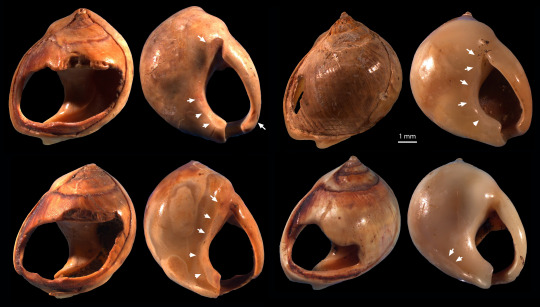
F. d’Errico [modified after d’Errico et al.
Beads of various materials, starting with shells and stones, spread widely with some speculating that trade of beads is what helped with the development of spoken language. It's even possible that beads go back as far as 500,000 years, to Homo erectus, though that is debated. Whether the beads were used in adornment or used as a type of currency or trade medium only is not known for sure, but beads are widely distributed and the materials show evidence of travel (for example, marine shell beads found in landlocked areas). It is thought, though, that wearing of beads came after decoration of the body with ochre.
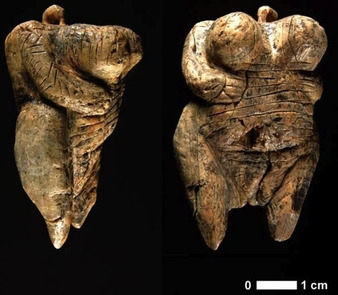
By http://www.nature.com/nature/videoarchive/prehistoricpinup/ image copyright H. Jensen / Universität Tübingen, Fair use, https://en.wikipedia.org/w/index.php?curid=22799118
The earliest depictions of clothing we have is around 41000 years ago, with the Venus of Hohle Fels, which was found in Sweden, though it is possible that the decorations on the body of the Venus figurine is ochre or tattoos. Interestingly, the oldest known musical instrument, a bone flute, was found near the Venus figure, indicating that fully behaviorally modern humans lived in the area.
Based on studies of head and body lice, humans began wearing clothing about 107,000 years ago. Part of the need for clothing was that this time was that this was during the start of the Last Glacial Maximum, when temperatures started dropping and glaciers began overtaking the northern latitudes. Humans, both Neanderthal and Homo Sapiens, had spread quite far by this time. Humans developed in the steppes of Africa and weren't well adapted to the cold, with no real body hair to hold in body heat.
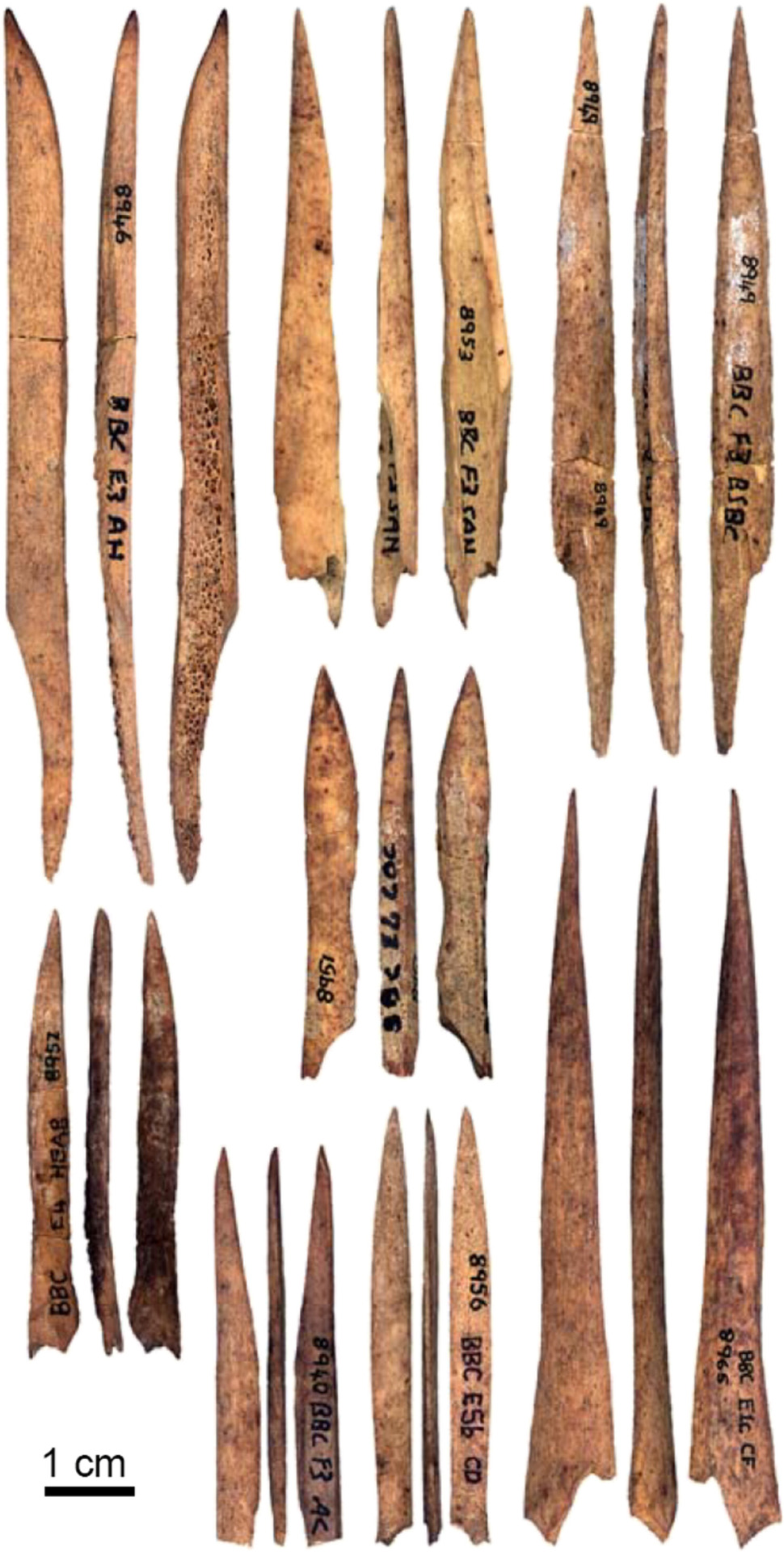

F. d’Errico.
Due to the organic nature of clothing, it's difficult to say for sure when exactly clothing began to be worn and what it was, but we are relatively certain that the first clothing was likely hides of animals. We have found stone and bone tools used to scrape hides from the Early and Middle Pleistocene. These tools also hold evidence that Ochre was used to color the hides. Awls, which were used in southern Africa approximately 73,000, years ago show that hides were pierced beginning very early. These awls show wear patterns of being used on soft, well-worked hides, though whether for clothing or bags, we can't know for sure. These awls spread to Europe by 45,000 years ago, though likely manufactured by Neanderthals based on the theorized distribution of various hominoid groups and remains in the locations they were found.
The benefit of using an awl to create holes in leather is that it can be shaped to the human body, making it more efficient at keeping the body warm, thus reducing the number of layers that need to be warn and allowing humans to spread further during the Last Glacial Maximum.
Approximately 40,000 years ago, in the Denisova Cave, at the time inhabited by modern humans, the first evidence of awls with eyes, or what we now know as needles, appear. This indicates that sewing together clothing, or the decoration of clothing, was becoming more common and more efficient. These needles spread widely, either through trade, contact, or independent development widely, even to the Americas and Australia. It is thought that this led to clothing being decorated more elaborately with beading and other forms of decoration.
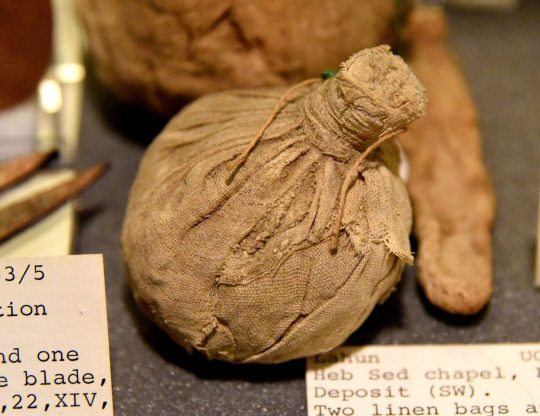
By Osama Shukir Muhammed Amin FRCP(Glasg) - Own work, CC BY-SA 4.0, https://commons.wikimedia.org/w/index.php?curid=56200885
While plant fibres don't generally fossilize, we do have some early evidence of people using them as early as 50,000 BCE, possibly used by Neanderthals, in southern France. There is are scattered imprints of cordage and net imprints in clay. As the planet warmed and the Holocene began, weaving of plant and animal fibres, depending on the local climate and availability. While weaving may have begun as early as 25,000 BCE, flax cultivation began around 8000 BCE, and the first evidence of weaving in 6000 BCE, used as a grave wrapping in Çatalhöyük. Approximately 3000 BCE, sheep were domesticated and bred for wooly fleece as opposed to hair in the Near East. In the Indus Valley, cotton was domesticated around 2500 BCE. Evidence of weaving beginning around 10,100 BCE have been found in the Americas, specifically Guitarreco Cave in Peru, where cotton and llama and alpaca were domesticated. Intricately dyed and woven silk was well developed as a craft as early as 2700 BCE, with the first silk reaching other places in the world nearly a thousand years earlier with the very first evidence of silk being used at all dating back to 8500 BCE.
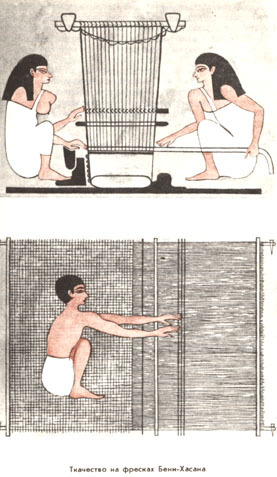
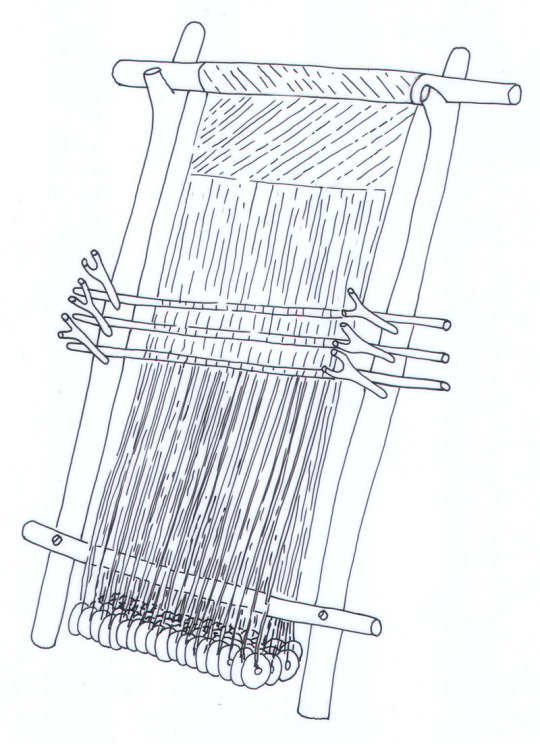
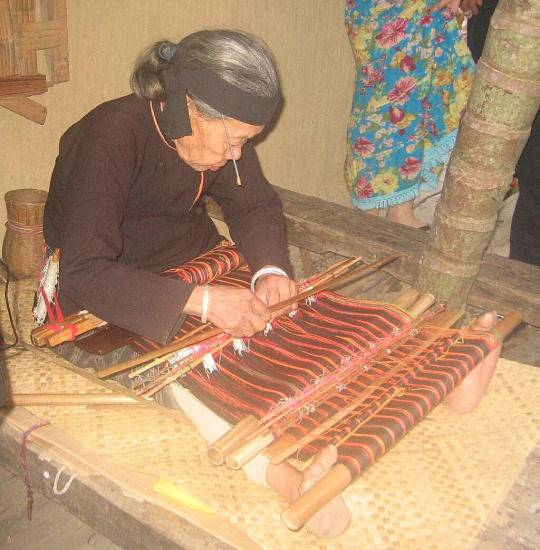
By Unknown author - http://www.booksite.ru/fulltext/nee/lov/tka/che/stvo/1.htm#1, Public Domain, https://commons.wikimedia.org/w/index.php?curid=7483824 By Annika Jeppsson og Danmarks Grundforskningsfonds Center for Tekstilforskning (CTR), Københavns Universitet, Attribution, https://commons.wikimedia.org/w/index.php?curid=33188674 By Zhou Guanhuai - Own work, CC BY-SA 4.0, https://commons.wikimedia.org/w/index.php?curid=142167208
It seems that civilizations may have developed weaving independently, so the first type of loom is difficult to figure out as some locations show that floor looms were first, while others show evidence of hanging looms, and yet others, it seems that what is now known as a 'back-strap loom' was first, while other locations show the use of a floor loom first. Given that these objects were made mostly of organic matter, the evidence comes from art, loom weights (stone or clay weights used to keep the warp threads taut while the loom was in use. Egyptian art shows the use of floor looms, Grecian urns show the use of warp-weighted looms, many native cultures used back-strap looms prior to European contact and colonization. From what fabrics that have been found, each culture developed its own method of creating decorated fabric, either through the application of decorations or through the weaving of the fabric itself, as well as multiple weights of cloth, from fine gauze through thick rugs out of nearly any plant or animal material that could be twisted into yarn.
#body decoration#weaving#sewing#leather work#floor loom#warp weight loom#back-strap loom#fabric#human history#human development
62 notes
·
View notes
Photo

Quentin used to Work @ #VideoArchives Today I have Officially Started as A Volunteer In wich is one of the last DVD Library Clubs, If You Want to Find Me @ The Lake Chapala Society I’ll Be Every Single Saturday at Axixic !!! 🇲🇽& 🇺🇸 (en The Lake Chapala Society A.C. - LCS) https://www.instagram.com/p/B482z9gFoVO/?igshid=h0c0r0tlnmxr
0 notes
Text
youtube
История о рекламе, балете и вдохновении
В ролях: Писцов Алексей, Добрынин Ян, Плакида Юлия, Владимир Тихонов, Цзю Вячеслав
Оператор-постановщик: Марат Убайдуллаев второй оператор: Сардор Алимов
Монтаж: Шавкат Юлдашев
Музыка: Алексей Поляков и All Tomorrow's Parties
Текст и постановка: Мусаелов Даниел
0 notes
Video
youtube
SOMA LABORATORY LYRA 8 // DRONE SYNTH // Jam Session // The HEFTY Part 2...
0 notes
Photo

بايگانى ۱۳۷۸-۱۳۷۲| ايران غزال رادپی پروژه های نیومدیا بیست و ششم، بیست هفتم و بیست و هشتم بهمن ماه ۱۳۹۷ ۴تا ۸ شب غزال رادپی در دیدار و گفتگو با امید قجریان و پوریا جهانشاد یکشنبه، بیست و هشتم بهمن ماه،شش بعد از ظهر پروژههای نیومدیا در تاریخ ۲۶-۲۷ - ۲۸ بهمن ۱۳۹۷، میزبان بخشی از آثار ویدیوییِ غزال رادپی خواهد بود، «بایگانی ۱۳۷۲-۱۳۷۸ | ایران» به نمایش چند ویدیوی کمتر به نمایش درآمده، اختصاص دارد که می تواند نمونههایی متقدم را در بررسی سیر هنر ویدیو در ایران، پیش بکشد: لحظاتی از همکاری رادپی با کاوه گلستان، نیز اجرایی در گالری ۱۳ ونک، به همراه چیدمانهایی در باغی خارج از شهر. نمایش بایگانی، روز یکشنبه با برگزاری نشستی به همراه هنرمند و مهمانانش امید قجریان و پوریا جهانشاد به پایان خواهد رسید. پرفورمنسها و نمايشگاههاى منتخب از ٧٢ تا ٧٨ كه در ايران اتفاق افتادند. «در تابستان سال ١٣٧١با كارهاى فتوگرام بزرگ روى پارچهی عكاسى (تاشده در چمدانم) به ايران آمدم، میخواستم يك نمايشگاه راه بیندازم. رفتم سراغ خانم سيحون چون دلم نمیخواست كه توى گالرى مادرم كار بگزارم. خانم سيحون يك نگاهى كرد و گفت بايد كارها كوچك شوند و براى تکتکشان اجازه رسمى گرفته شود. من از نگارخانهی ايشان بيرون آمده و به خودم گفتم هیچگاه هیچکس حق ندارد از من بخواد كارم را تغيير بدم و هیچگاه هیچکس حق ندارد براى من تعيين كند كه كارم را مى شه و يا نمى شه نشان بدهم. درهرحال همان روزها پدرم سکتهی مغزى كرد و فكر نمايشگاه ديگر جايى در سرم نداشت. تابستان بعد دوباره همان كارها را با خودم اوردم و تصميم گرفتم كه توى خانه قرمزی كه خانهی آخر هفتهی بچگيمون در باغ خانوادگى بود و از مرگ پدربزرگم ول شده بود نمايشگاه چندساعته بگذارم...» پروژههای نیومدیا تهران، کریمخان، خردمند شمالی، اعرابی ۳، شمارهی ۳ #ghazalradpey #newmediaprojects #videoarchive #artisttalk @newmediasociety (at New Media Projects - پروژههای نیو مدیا) https://www.instagram.com/p/BtzJ95uhkdj/?utm_source=ig_tumblr_share&igshid=g7pqwqi2r5zr
0 notes
Text
Zähe Zeit: Manfred Erjautz - kulturMontag vom 13.06.2022 um 22:40 Uhr – ORF-TVthek
Zähe Zeit: Manfred Erjautz – kulturMontag vom 13.06.2022 um 22:40 Uhr – ORF-TVthek
Nachrichten, Magazine, Dokumentationen, Diskussionen, Kultur, Sport, Shows, Comedys, Filme, Serien, Regional- und Kindersendungen: Die Videoplattform ORF-TVthek bietet mehr als 200 ORF-TV-Sendungen als Livestream und Video-on-Demand an. Die Videoarchive erlauben zudem einen Blick ins ORF-Archiv zu zeit- und kulturgeschichtlichen Themen. — Weiterlesen tvthek.orf.at/
View On WordPress
0 notes
Video
instagram
Riversamentivideo centro leader in Italia per il riversamento video professionale in qualità broadcast. Lettori di qualsiasi formato audio video e pellicola. Qualità garantita da anni di esperienza e professionalità. Richiedi un preventivo a https://www.riversamentivideo.it saremo lieti di poter essere al suo servizio. ... #dvd #vhs #riversamentivideo #video #minidv #riversamentivhs #super8 #riversamentisudvd #photo #familymemories #archive #familyhistory #vhsc #videoediting #family #videotape #negativo #diapositive #pellicole #audio #persempresudvd #pellicola #regular8 #45giri #riversamento #videotodvd #editvideo #lp #videotodvdtransfer #videoarchive Powered by @mgvideo (presso Umbria) https://www.instagram.com/p/CRDl29hiiez/?utm_medium=tumblr
#dvd#vhs#riversamentivideo#video#minidv#riversamentivhs#super8#riversamentisudvd#photo#familymemories#archive#familyhistory#vhsc#videoediting#family#videotape#negativo#diapositive#pellicole#audio#persempresudvd#pellicola#regular8#45giri#riversamento#videotodvd#editvideo#lp#videotodvdtransfer#videoarchive
0 notes
Text
Überwachungskameras bei Tesla, Polizei und Schulen geknackt
150.00 Überwachungskameras lieferten Unbefugten Bilder frei Haus, auch aus Gefängnissen und Spitälern. Selbst umfangreiche Videoarchive standen offen. Read more www.heise.de/news/…... www.digital-dynasty.net/de/teamblogs/…

http://www.digital-dynasty.net/de/teamblogs/uberwachungskameras-bei-tesla-polizei-und-schulen-geknackt
0 notes
Video
youtube
WALDORF NW-1// Sequences + FX // Wavetable Module // Part 3
0 notes
Photo

50,000 photos; 6,000 videos While raising her son, Victoria Mapplebeck shot a vast amount of visual material. Even for a professional documentarian, 50,000 photos and 6,000 videos is a lot of material. Mapplebeck put that digital archive to good use in making “Missed Call,” a BAFTA-winning documentary about her son’s desire to meet his long-absent father. You can see this remarkable 19-minute documentary—which is the current Mobile Movie of the Week—at MobileMovieMaking (link in profile) #documentary #parenting #shotoniPhone #videoarchive https://www.instagram.com/p/CP_RLFvhAYg/?utm_medium=tumblr
0 notes
Video
Next Wednesday Foundland will be speak at @the.hmm internet culture talk series at @fanfare_amsterdam de Costakade 154, Amsterdam West ✌️#videoarchive #realtimehistory #foundlandcollective #futurearchives (at Stadsdeel West Amsterdam) https://www.instagram.com/p/BvPT6XohD7G/?utm_source=ig_tumblr_share&igshid=2pwf4obp5xyi
0 notes
Photo

Video: A helmet you can wear while doing magnetoencephalography (MEG). https://www.nature.com/nature/videoarchive/brainwaves/index.html
0 notes
